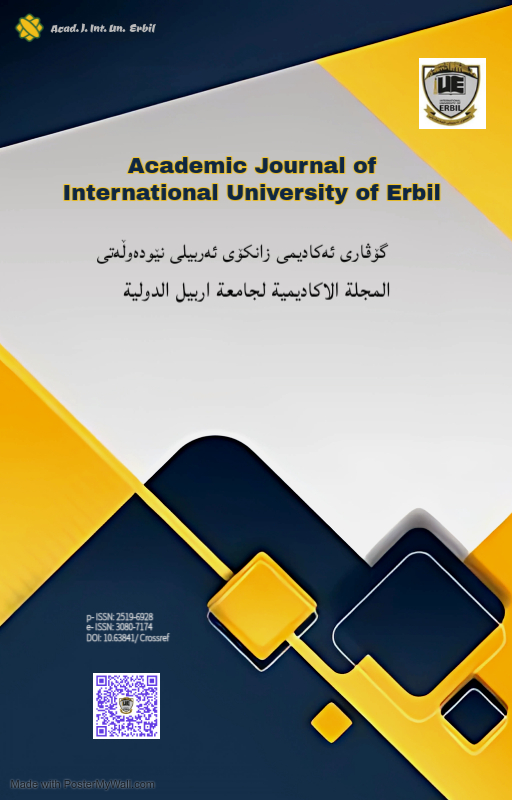Beyond IFRS 9: Examining Liquidity, Credit, and Capital Risks in Banking Performance - Evidence from Iraqi Banks
Beyond IFRS 9: Examining Liquidity, Credit, and Capital Risks in Banking Performance
DOI:
https://doi.org/10.63841/iue23574Keywords:
Banking Performance, Liquidity Risk, Capital Adequacy, IFRS 9 Compliance, Panel Data RegressionAbstract
This study examines the impact of IFRS 9 adoption, liquidity risk, credit risk, and capital adequacy on banking performance, as measured by Return on Assets (ROA), Tobin's Q (TQ), and Earnings Per Share (EPS), using a panel data regression model with 187 observations from 2014 to 2024. The data is collected from the Iraqi Stock Exchange. The findings show that liquidity risk (LCR, LDR) has a significant impact on profitability and earnings, emphasizing the need for liquidity management in ensuring banking stability. Capital adequacy (CAR, Tier 1 Capital) is critical for market value, however, IFRS 9 adoption has a significant impact on earnings but has little effect on profitability or valuation, indicating that regulatory compliance is primarily concerned with financial reporting. Significantly, credit risk indicators (LLP, NPL) had no significant influence on any performance metric, suggesting that short-term banking performance is more dependent on liquidity and capital sufficiency than credit risk. The study also found that firm-specific factors, particularly Firm Size (FS) and Firm Growth (FG), significantly increase banking performance across all models, implying that larger, growing banks outperform their smaller counterparts. The Hausman test findings endorse the Fixed Effects model for TQ, the Random Effects model for EPS, and the Pooled OLS model for ROA, therefore assuring model robustness. These results underscore the need for banks to maximize liquidity buffers, capital reserves, and risk management frameworks to bolster financial stability and promote long-term development. Policymakers must maintain a balanced regulatory framework that promotes openness and guarantees financial resilience. Subsequent study may investigate macroeconomic factors and the enduring impacts of credit risk on banking performance.
References
E. Philip Kendy, D. Akpan, & J. Ime Edet, “Assessing the Effect of Fair Value Accounting on Market Value of Deposit Money Banks in Nigeria,” Indo-Asian Journal of Finance and Accountings, vol.4, no.2, pp.213–240, 2023. https://doi.org/10.47509/IAJFA.2023.v04i02.02.
B. H. Mohammed, H. Rasheed, R. W. Maseer, & A. J. Al-Waeli, “The Impact of Mandatory IFRS Adoption on Accounting Quality: Iraqi Private Banks,”International Journal of Innovation, Creativity and Change, vol.13, no.5, pp.87-103, 2020.
E. E. Alharasis, “The implementation of IFRS electronic financial reporting – XBRL and usefulness of financial information: evidence from Jordanian finance industry,” International Journal of Law and Management. vol.x, no. x, 2025. https://doi.org/10.1108/IJLMA-07-2024-0233
M. T. T. Al-Taweel, & H. Benmabrouk, “The impact of applying international accounting standards on the tax base: an applied study of a sample of banks listed on the Iraq stock exchange. Journal of Lifestyle and SDG’S Review, vol.4, no.4, e03555, 2024. https://doi.org/10.47172/2965-730X.SDGsReview.v4.n04.pe03555,
D. D. Asmare, & P. P. Viswanadham, “Level of Disclosure Compliance with IAS/IFRS: Empirical Evidence from Ethiopian Commercial Banks,” Innovations, vol.68, no.3, pp.362-380, 2022.
M. A. J. Al-Kefari, A. R. Abed, & F. S. Hassoon “Effect of Expected Losses Model in Banks’ Performance under International Financial Reporting Standard in Iraqi Banks (Applied Study),” World Economics and Finance Bulletin, vol.31, pp.52-59, 2024.
A. M. H. Al-Hashimi, & H. A. Abdel-Sada, “Measuring Market Risk in Accordance with International Financial Reporting Standards using Value at Risk: An Applied Study in Baghdad Soft Drinks Company. Al-Furat Journal of Innovations in Management Science, vol.1, no.1, pp.88-101, 2025.
Y. Oubahou, & K. El Ouafa, “The effect of adopting IFRS on the relevance of information: The case of Moroccan companies listed on the Casablanca Stock Exchange,” Investment Management and Financial Innovations, vol.21, no.2, pp.389–399, 2024. https://doi.org/10.21511/imfi.21(2).2024.32.
M. Di, & B. Filho, “Universidade Estadual de Campinas Instituto de Economia. 2022. www.tcpdf.org.
N. H. Radhi, “Application of Financial Accounting Tools System According to the ifrs-9 Standard and its Role in Improving the Quality of Accounting Information (Applied Study in a sample of Financial Companies listed in the Iraq Stock Exchange). Spectrum Journal of Innovation, Reforms and Development, vol.16, pp.12-23, 2023.
H. Daske, L. Hail, C. Leuz, & R. Verdi, R. (2008). Mandatory IFRS Reporting Around the World: Early Evidence on the Economic Consequences “Providing thought leadership on financial markets, international business and public policy,” Journal of Accounting Research, vol. 46, no. 5, pp.1085-1142, 2008.
A. R. Admati, P. Pfleiderer, M. Barth, B. Beaver, F. Gul, D. Kreps, et al., “Forcing Firms to Talk: Financial Disclosure Regulation and Externalities,” The Review of Financial Studies, vol.13, no. 3, pp.479-519, 2000.
Q. Cheng, G.Yu, & L. Hail, “The past, present, and future of China-related accounting research,” Journal of Accounting and Economics, vol.74, no.2-3, pp.1-15, 2022.
A. Maulana, M. Dwita, M. Fitriyani, D. Sunaryo, & Y. Adiyanto, Y, “Risk Management As A Determinant Of Indonesian Banking Financial Performance: A Systematic Literature Approach,” Indo-Fintech Intellectuals: Journal of Economics and Business, vol.4, no.5, pp.2523–2537, 2024. https://doi.org/10.54373/ifijeb.v4i5.2120
S. R. Hussein, Y. A. Wahab, & N. A. Fatah, “The role of local product festivals in attracting tourists: a Halabja case analysis,” British Journal of Interdisciplinary Research, vol.1, no.1, pp. 90–109, 2024.
D. Beerbaum, & S. Ahmad, “Credit Risk according to IFRS 9: Significant increase in Credit Risk and implications for Financial Institutions. 2015. DOI:10.2139/ssrn.2654120.
S. García-Villegas, & E. Martorell, “Climate transition risk and the role of bank capital requirements,” Economic Modelling, vol.135, pp.106724, 2024. https://doi.org/10.1016/j.econmod.2024.106724.
Z. Al-Husseini, “The Impact of Applying International Standard nine on the Quality of Accounting Information,” International Journal of Business and Management Sciences, vol.4, no.5, pp.170–190, 2024. https://doi.org/10.55640/ijbms-04-05-14
K. F., Kubayevich, “Current Analysis and Current Issues of Ensuring the Financial Stability of the Banking System in Uzbekistan,” European Journal of Business Startups and Open Society, vol.4, no. 3, pp.169-176, 2024.
J. Hausman, “Specification Tests in Econometrics,” Econometrica, vol.46, pp.1251-1271, 1978.
https://doi.org/10.2307/1913827
P. Bojar, &M. A. Olszak, “The Impact of IFRS 9 on the Link Between Lending and the Capital Ratio in Publicly Traded Banks in Poland,” Journal of Banking and Financial Economics, vol.1, no.17, pp.60–73. 2022. https://doi.org/10.7172/2353-6845.jbfe.2022.1.4
V. Grosu, L. Ionescu-Feleagă, A. G. Macovei, M. S. Ciubotariu, E. Hlaciuc, M. Socoliuc, C. Petrescu, “The Impact of IFRS 9 Adoption on the Financial Performance and Sustainability of Romanian Credit Institutions,” Eastern European Economics, 2024. https://doi.org/10.1080/00128775.2024.2368031
J. S. Kolawole, A. W. Alabi, & N. S. Awotomilusi, “IFRS 6 Accounting Options and the Value Relevance of Oil & Gas Firms in Nigeria. Journal of Management World, vol.2025, no.2, pp.78–91, 2025. https://doi.org/10.53935/jomw.v2024i4.870
B. Basvi, “Evaluating the Effect of Fundamental Analysis on Earnings Per Share Concept in Stock Valuation in the Zimbabwe Stock Exchange Market,” International Journal of Research and Scientific Innovation, vol. 11, no.5, pp531-550, 2024.
O. Pastiranová, & J. Witzany, “Ifrs 9 and its Behaviour in the Cycle: the Evidence on EU Countries,” Journal of International Finance, Management and Accounting, vol.33, pp.5-17, 2022.
L. Ali, M. Hassan, L. Oday, & J. Challab, “The role of the External Auditor in Monitoring the Compliance of Gulf Commercial and Baghdad Banks with the Instructions of the Central Bank of Iraq Regarding Capital Adequacy Ratios (Case Study of Gulf Commercial and Baghdad Banks),” World Economics and Finance Bulletin, vol.32, pp.119-131, 2024.
M. Machrafi, D. Uckar, T. Susak, “Economic and Social Development,” 79th International Scientific Conference on Economic and Social Development, Book of Proceedings. Rabat, 25-26 March, 2022
C. M. F. Mala, “The Role of Loan Loss Provisions in Competition Toward Bank Stability,” Dinasti International Journal of Economics, Finance &Amp; Accounting, vol.5, no.2, pp.717–729, 2024.
C. Adhim, M. Departement, & M. Mulyati, “The Influence of Capital Adequacy Ratio (CAR), Non-Performing Loan (NPL), Loan to Deposit Ratio (LDR), and Operational Costs to Operating Income (BOPO) on Return on Asset (ROA) in Banks Listed on the Indonesia Stock Exchange,” International Journal of Science Technology and Management, vol.4, no.5, pp.1067-1075, 2024. DOI:10.46729/ijstm.v4i5.1189.
P. Q. Tran., A. Phan, T. V. Dung, & M. H. Shahrour, “The effect of capital empowerment on the lending competence of banks: Evidence from segmental analysis,” Economics Bulletin, vol.44, no.2, 2024.
A. Olawale, “Capital adequacy and financial stability: A study of Nigerian banks’ resilience in a volatile economy,” GSC Advanced Research and Reviews, vol.21, no.1, pp1-12, 2024. https://doi.org/10.30574/gscarr.2024.21.1.0346.
X. Li, J. Ng, W. Saffar, “Accounting-Driven Bank Monitoring and Firms’ Debt Structure: Evidence from IFRS 9 Adoption, Management Science, vol.70, no.1, 2022. https://doi.org/10.1287/mnsc.2022.4628.
H. Abdullah, & T. Tursoy, “ Capital structure and firm performance: evidence of Germany under IFRS adoption,” Review of Managerial Science, vol.15, no.2, pp.379–398, 2022. https://doi.org/10.1007/s11846-019-00344-5.
W. Alim, A Ali, & A. S. Minhas, “The Impact of Leverage on the Firm Performance: A Case of Fertilizers Sector of Pakistan,” Munich Personal RePEc Archive, Paper no.114200, pp.1-16, 2022. https://mpra.ub.uni-muenchen.de/114200/
Y. Matsushita, & T. Otsu, “A jackknife Lagrange multiplier test with many weak instruments,” Econometric Theory, vol.40, no.2, pp.447-470, 2024. DOI: https://doi.org/10.1017/S0266466622000433.
Downloads
Published
Issue
Section
License
Copyright (c) 2025 Academic Journal of International University of Erbil

This work is licensed under a Creative Commons Attribution-NonCommercial-NoDerivatives 4.0 International License.












